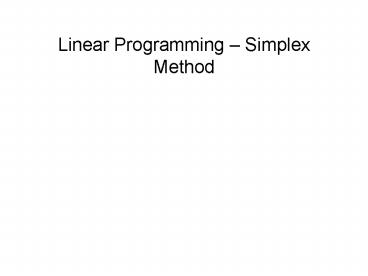Linear Programming - PowerPoint PPT Presentation
Title:
Linear Programming
Description:
What is the feasible region? Where was optimal solution found? ... Step 5 Use EROs to find the new bfs with the better objective function value. Go back to step 3. ... – PowerPoint PPT presentation
Number of Views:33
Avg rating:3.0/5.0
Title: Linear Programming
1
Linear Programming Simplex Method
2
Linear Programming - Review
- Graphical Method
- What is the feasible region?
- Where was optimal solution found?
- What is primary limitation of graphical method?
- Conversion to Standard Form
- -
- -
- -
3
Linear Programming Review
- Solving Systems of Linear Equations
- What is a basic solution?
- How did we obtain a basic solution?
- What is a basic feasible solution?
- Relationship between graphical and algebraic
- representation of the feasible region
- corner point basic solution
4
Linear Programming Review
Fundamental insight the optimal solution to a
linear program, if it exists, is also a basic
feasible solution. Naïve approach solve for
all basic solutions and find the feasible
solution with the largest value (maximization
problem). What is the problem with this
approach? there are possible basic
solutions, where m is the number of constraints
and n is the number of variables.
5
Linear Programming Simplex Algorithm
Step 1 Convert the LP to standard form. Step
2 Obtain a bfs (if possible) from the standard
form. Step 3 Determine whether the current bfs
is optimal. Step 4 If the current bfs is not
optimal, then determine which nonbasic basic
variable should become a basic variable and which
basic variable should become a nonbasic variable
to find a new bfs with a better objective
function value. (pivot operation) Step 5 Use
EROs to find the new bfs with the better
objective function value. Go back to step 3.
Operations Research, Wayne L. Winston
6
Linear Programming Simplex Method
Review Simplex Handouts
7
Linear Programming Simplex Method
Minimization Problems
Min Z cx ? (-) Max Z -cx Ex. Min
2x1 3x2 x3 s.t. x1 2x2
lt 5 2x1 - 3x3 gt
10 x1, x2, x3 gt 0
(-)Max -2x1 3x2 - x3 s.t. x1
2x2 lt 5 2x1 -
3x3 gt 10 x1, x2, x3 gt 0
8
Linear Programming Simplex Method
Computational Problems
Breaking Ties in Selection of Non-Basic Variable
if tie for non-basic variable with largest
relative profit ( ), arbitrarily select
incoming variable. Ties in Minimum Ratio Rule
(Degeneracy) if more than one basic variable
have same minimum ratio, select either
variable to leave the basis. This will result in
a basic variable taking on a value of 0. When
this occurs, the solution is referred to as a
degenerate basic feasible solution. When this
occurs, you may transition through more than one
simplex tableau with the same objective (Z)
value.
9
Linear Programming Simplex Method
Computational Problems
Unbounded Solutions if when performing the
minimum ratio rule, none of the ratios are
positive, then the solution is unbounded (e.g Max
Z or Min - ).
10
Simplex Method Finding an Initial Basic
Feasible Solution
Min Z -3x1 x2 x3 s.t. x1
2x2 x3 lt 11 -4x1 x2 2x3 gt
3 2x1 - x3 -1
x1, x2, x3 gt 0 Standard Form (-) Max Z
3x1 - x2 - x3 s.t. x1 2x2
x3 x4 11 -4x1
x2 2x3 -x5 3
-2x1 x3 1 x1, x2,
x3, x4, x5 gt 0
11
Simplex Method Finding an Initial Basic
Feasible Solution
(-) Max Z 3x1 - x2 - x3 s.t.
x1 2x2 x3 x4 11
-4x1 x2 2x3 -x5 3
-2x1 x3
1 x1, x2, x3, x4, x5 gt 0 Only x4 is
basic. Introduce artificial variables.
s.t. x1 2x2 x3 x4
11 -4x1 x2 2x3
-x5 x6 3
-2x1 x3 x7
1 x1, x2, x3, x4, x5, x6, x7 gt 0
12
Simplex Method Solve Using Big-M Method
Let M be an arbitrarily large number, then (-)
Max Z 3x1 - x2 - x3 0x4 0x5 Mx6
Mx7 s.t. x1 2x2 x3 x4
11
-4x1 x2 2x3 -x5 x6
3 -2x1
x3 x7
1 x1, x2, x3, x4, x5, x6, x7 gt 0
Note If the simplex algorithm terminates with
one of the artificial variables as a basic
variable, then the original problem has no
feasible solution.































